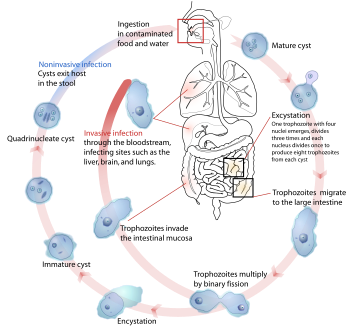Entamoeba histolytica

- Reason
- it was already nominated and was not promoted becouse of missing quorum, so i was hoping more people would be interested this time hereis the past nomination.
- Articles this image appears in
- Amoebiasis, Entamoeba histolytica
- Creator
- Mariana Ruiz LadyofHats
- nominator -- LadyofHats ( talk) 11:12, 10 July 2008 (UTC)
- Comment: Though a nice and informative illustration, I have to take issue with the size of the text. I should be able to at least read the headings of the diagram. Seeing it used in the articles, I suppose they could be sized a tad bigger there, but I still think the size of the diagram is too small.
Spencer
T♦
C 23:45, 11 July 2008 (UTC)
- alredy made it bigger but it has no sence to do so since it is an svg. anyway. i also aded a numbered version- LadyofHats ( talk) 10:56, 12 July 2008 (UTC)
- Strong oppose The cysts of various gut infecting organisms can be partially identified by the appearance of their nuclei, but this diagram does not show the cyst with karyosomes in the nuclei. If there is a reference for this diagram that can explain why this image is done without the usual karyosomes, let me know, otherwise, no. There are quite a few other problems with this image, and it should be removed from the articles for now, until it can be vetted and corrected by a biologist. --
Blechnic (
talk) 06:08, 13 July 2008 (UTC)
- Comment
first: This diagram deals with the life-cycle of entamoeba histolytica and not with the ultrastructure of the nucleus. For a good, useful diagram it is necessary to concentrate of the essentials and ommit arcane details for didactic reasons. However, after reading your message i made a little investigation regarding karyosomes. So here it is what i found: Karyosome is a dense area of chromatin in the nucleus, as it can be seen here in a iodamoeba buetschlii. In general it is recognised as a dark area inside the nucleus. Yet acording to the book "medizinische Mikrobiologie" (Ernst Wiesmann, Thieme 6. Auflage ISBN 3 13 444806 8) the Entamoeba histolytica species is not recognised by a prominant karyosome compared to e. g. iodamoeba buetschlii or endolimax nana. A similar much more simplified diagram for reference is here showing the same. It is therefore no need to include karysome appearance in this diagram. By the way today diagnosis of entamoeba species is done using Polymerase chain reaction and hardly with ultrastructural analysis because of the high failure rate relying on visual appearance.
- Now as you where so friendly to ask i added some minimal points Maybe that improves your mood - LadyofHats ( talk) 08:30, 13 July 2008 (UTC)
- Please keep the conversation on the topic, not on my mood, or any other personal speculation about me. Thank you.
- Actually, I think ELISA is the preferred method, although PCR is also used.
- That is correct, it is not identified by a prominent karyosome. That is because similar cysts produced by other organisms have nuclei with more prominent karyosomes not because E. histolytica does not have a visible karyosome. The simplified diagram you link to shows the cyst as it is almost always portrayed, with four nuclei each with a visible and somewhat centrally located karyosome. And similar cysts of other organisms with more prominent karyosomes.
- PCR was not much used in 1971, the date of publication of the textbook you mention, and I cannot find it under its ISBN to find out if this is a newer version. As the issue of identification of E. histolytica changed completely in the early 1990s using a textbook from 1970ish as a source, particularly when you bring up PCR, is probably not the best reference to be using for this illustration.
- The ultrastructure of the nucleus includes far more than the distribution of its chromatin.
- Illustrations of the life cycle of E. histolytica commonly include the karyosome in the nucleus. Unless you can establish that they don't, your choice is simply original research, and that, along with personal attacks is a no-no. Also, it's not the "high failure rate relying on visual appearance" that makes PCR, ELISA and other techniques necessary, it cysts are simply not differentiated from the non-disease causing species using electron microscopy. -- Blechnic ( talk) 08:52, 13 July 2008 (UTC)
- Oppose per Blechnic. Becky Sayles ( talk) 00:19, 16 July 2008 (UTC)
Not promoted MER-C 06:51, 18 July 2008 (UTC)